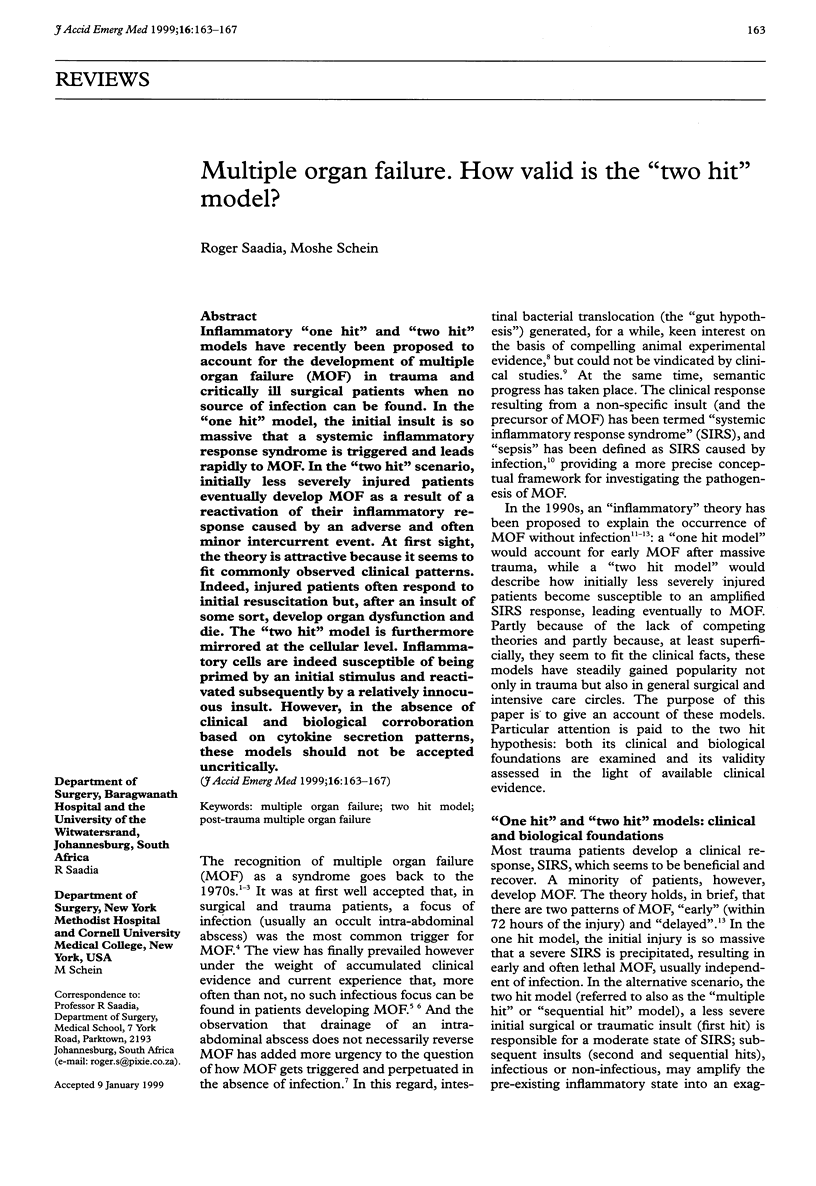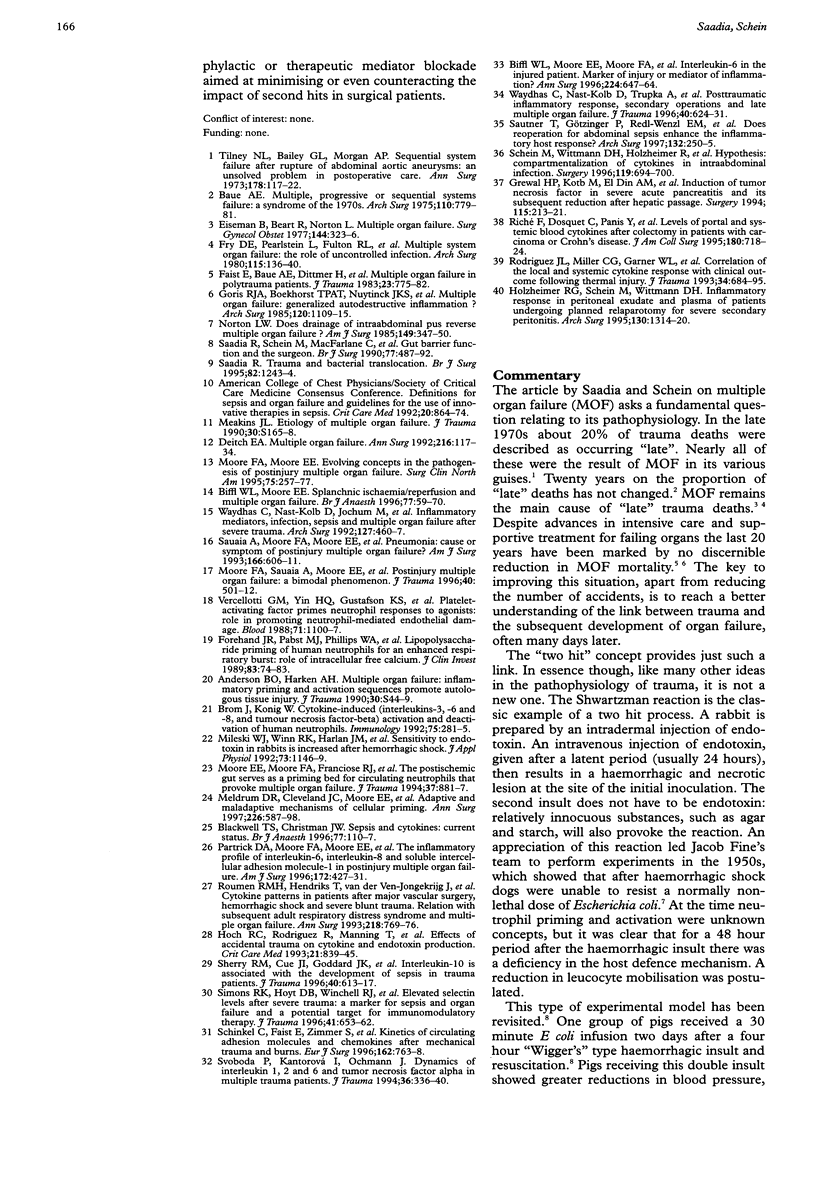Abstract
Inflammatory "one hit" and "two hit" models have recently been proposed to account for the development of multiple organ failure (MOF) in trauma and critically ill surgical patients when no source of infection can be found. In the "one hit" model, the initial insult is so massive that a systemic inflammatory response syndrome is triggered and leads rapidly to MOF. In the "two hit" scenario, initially less severely injured patients eventually develop MOF as a result of a reactivation of their inflammatory response caused by an adverse and often minor intercurrent event. At first sight, the theory is attractive because it seems to fit commonly observed clinical patterns. Indeed, injured patients often respond to initial resuscitation but, after an insult of some sort, develop organ dysfunction and die. The "two hit" model is furthermore mirrored at the cellular level. Inflammatory cells are indeed susceptible of being primed by an initial stimulus and reactivated subsequently by a relatively innocuous insult. However, in the absence of clinical and biological corroboration based on cytokine secretion patterns, these models should not be accepted uncritically.
Full text
PDF



Selected References
These references are in PubMed. This may not be the complete list of references from this article.
- Anderson B. O., Harken A. H. Multiple organ failure: inflammatory priming and activation sequences promote autologous tissue injury. J Trauma. 1990 Dec;30(12 Suppl):S44–S49. [PubMed] [Google Scholar]
- Baue A. E. Multiple, progressive, or sequential systems failure. A syndrome of the 1970s. Arch Surg. 1975 Jul;110(7):779–781. doi: 10.1001/archsurg.1975.01360130011001. [DOI] [PubMed] [Google Scholar]
- Biffl W. L., Moore E. E., Moore F. A., Peterson V. M. Interleukin-6 in the injured patient. Marker of injury or mediator of inflammation? Ann Surg. 1996 Nov;224(5):647–664. doi: 10.1097/00000658-199611000-00009. [DOI] [PMC free article] [PubMed] [Google Scholar]
- Biffl W. L., Moore E. E. Splanchnic ischaemia/reperfusion and multiple organ failure. Br J Anaesth. 1996 Jul;77(1):59–70. doi: 10.1093/bja/77.1.59. [DOI] [PubMed] [Google Scholar]
- Blackwell T. S., Christman J. W. Sepsis and cytokines: current status. Br J Anaesth. 1996 Jul;77(1):110–117. doi: 10.1093/bja/77.1.110. [DOI] [PubMed] [Google Scholar]
- Brom J., König W. Cytokine-induced (interleukins-3, -6 and -8 and tumour necrosis factor-beta) activation and deactivation of human neutrophils. Immunology. 1992 Feb;75(2):281–285. [PMC free article] [PubMed] [Google Scholar]
- Deitch E. A. Multiple organ failure. Pathophysiology and potential future therapy. Ann Surg. 1992 Aug;216(2):117–134. doi: 10.1097/00000658-199208000-00002. [DOI] [PMC free article] [PubMed] [Google Scholar]
- Eiseman B., Beart R., Norton L. Multiple organ failure. Surg Gynecol Obstet. 1977 Mar;144(3):323–326. [PubMed] [Google Scholar]
- Faist E., Baue A. E., Dittmer H., Heberer G. Multiple organ failure in polytrauma patients. J Trauma. 1983 Sep;23(9):775–787. doi: 10.1097/00005373-198309000-00002. [DOI] [PubMed] [Google Scholar]
- Forehand J. R., Pabst M. J., Phillips W. A., Johnston R. B., Jr Lipopolysaccharide priming of human neutrophils for an enhanced respiratory burst. Role of intracellular free calcium. J Clin Invest. 1989 Jan;83(1):74–83. doi: 10.1172/JCI113887. [DOI] [PMC free article] [PubMed] [Google Scholar]
- Fry D. E., Pearlstein L., Fulton R. L., Polk H. C., Jr Multiple system organ failure. The role of uncontrolled infection. Arch Surg. 1980 Feb;115(2):136–140. doi: 10.1001/archsurg.1980.01380020006003. [DOI] [PubMed] [Google Scholar]
- Goris R. J., te Boekhorst T. P., Nuytinck J. K., Gimbrère J. S. Multiple-organ failure. Generalized autodestructive inflammation? Arch Surg. 1985 Oct;120(10):1109–1115. doi: 10.1001/archsurg.1985.01390340007001. [DOI] [PubMed] [Google Scholar]
- Grewal H. P., Kotb M., el Din A. M., Ohman M., Salem A., Gaber L., Gaber A. O. Induction of tumor necrosis factor in severe acute pancreatitis and its subsequent reduction after hepatic passage. Surgery. 1994 Feb;115(2):213–221. [PubMed] [Google Scholar]
- Hoch R. C., Rodriguez R., Manning T., Bishop M., Mead P., Shoemaker W. C., Abraham E. Effects of accidental trauma on cytokine and endotoxin production. Crit Care Med. 1993 Jun;21(6):839–845. doi: 10.1097/00003246-199306000-00010. [DOI] [PubMed] [Google Scholar]
- Holzheimer R. G., Schein M., Wittmann D. H. Inflammatory response in peritoneal exudate and plasma of patients undergoing planned relaparotomy for severe secondary peritonitis. Arch Surg. 1995 Dec;130(12):1314–1320. doi: 10.1001/archsurg.1995.01430120068010. [DOI] [PubMed] [Google Scholar]
- Meldrum D. R., Cleveland J. C., Jr, Moore E. E., Partrick D. A., Banerjee A., Harken A. H. Adaptive and maladaptive mechanisms of cellular priming. Ann Surg. 1997 Nov;226(5):587–598. doi: 10.1097/00000658-199711000-00003. [DOI] [PMC free article] [PubMed] [Google Scholar]
- Mileski W. J., Winn R. K., Harlan J. M., Rice C. L. Sensitivity to endotoxin in rabbits is increased after hemorrhagic shock. J Appl Physiol (1985) 1992 Sep;73(3):1146–1149. doi: 10.1152/jappl.1992.73.3.1146. [DOI] [PubMed] [Google Scholar]
- Moore E. E., Moore F. A., Franciose R. J., Kim F. J., Biffl W. L., Banerjee A. The postischemic gut serves as a priming bed for circulating neutrophils that provoke multiple organ failure. J Trauma. 1994 Dec;37(6):881–887. doi: 10.1097/00005373-199412000-00002. [DOI] [PubMed] [Google Scholar]
- Moore F. A., Moore E. E. Evolving concepts in the pathogenesis of postinjury multiple organ failure. Surg Clin North Am. 1995 Apr;75(2):257–277. doi: 10.1016/s0039-6109(16)46587-4. [DOI] [PubMed] [Google Scholar]
- Moore F. A., Sauaia A., Moore E. E., Haenel J. B., Burch J. M., Lezotte D. C. Postinjury multiple organ failure: a bimodal phenomenon. J Trauma. 1996 Apr;40(4):501–512. doi: 10.1097/00005373-199604000-00001. [DOI] [PubMed] [Google Scholar]
- Norton L. W. Does drainage of intraabdominal pus reverse multiple organ failure? Am J Surg. 1985 Mar;149(3):347–350. doi: 10.1016/s0002-9610(85)80105-7. [DOI] [PubMed] [Google Scholar]
- Riché F., Dosquet C., Panis Y., Valleur P., Laisné M. J., Briard C., Wautier J. L. Levels of portal and systemic blood cytokines after colectomy in patients with carcinoma or Crohn's disease. J Am Coll Surg. 1995 Jun;180(6):718–724. [PubMed] [Google Scholar]
- Rodriguez J. L., Miller C. G., Garner W. L., Till G. O., Guerrero P., Moore N. P., Corridore M., Normolle D. P., Smith D. J., Remick D. G. Correlation of the local and systemic cytokine response with clinical outcome following thermal injury. J Trauma. 1993 May;34(5):684–695. doi: 10.1097/00005373-199305000-00011. [DOI] [PubMed] [Google Scholar]
- Roumen R. M., Hendriks T., van der Ven-Jongekrijg J., Nieuwenhuijzen G. A., Sauerwein R. W., van der Meer J. W., Goris R. J. Cytokine patterns in patients after major vascular surgery, hemorrhagic shock, and severe blunt trauma. Relation with subsequent adult respiratory distress syndrome and multiple organ failure. Ann Surg. 1993 Dec;218(6):769–776. doi: 10.1097/00000658-199312000-00011. [DOI] [PMC free article] [PubMed] [Google Scholar]
- Saadia R., Schein M., MacFarlane C., Boffard K. D. Gut barrier function and the surgeon. Br J Surg. 1990 May;77(5):487–492. doi: 10.1002/bjs.1800770505. [DOI] [PubMed] [Google Scholar]
- Saadia R. Trauma and bacterial translocation. Br J Surg. 1995 Sep;82(9):1243–1244. doi: 10.1002/bjs.1800820928. [DOI] [PubMed] [Google Scholar]
- Sauaia A., Moore F. A., Moore E. E., Haenel J. B., Read R. A. Pneumonia: cause or symptom of postinjury multiple organ failure? Am J Surg. 1993 Dec;166(6):606–611. doi: 10.1016/s0002-9610(05)80664-6. [DOI] [PubMed] [Google Scholar]
- Sautner T., Götzinger P., Redl-Wenzl E. M., Dittrich K., Felfernig M., Sporn P., Roth E., Függer R. Does reoperation for abdominal sepsis enhance the inflammatory host response? Arch Surg. 1997 Mar;132(3):250–255. doi: 10.1001/archsurg.1997.01430270036006. [DOI] [PubMed] [Google Scholar]
- Schein M., Wittmann D. H., Holzheimer R., Condon R. E. Hypothesis: compartmentalization of cytokines in intraabdominal infection. Surgery. 1996 Jun;119(6):694–700. doi: 10.1016/s0039-6060(96)80195-4. [DOI] [PubMed] [Google Scholar]
- Schinkel C., Faist E., Zimmer S., Piltz S., Walz A., Rose R., Höcherl E., Herndon D., Schildberg F. W. Kinetics of circulating adhesion molecules and chemokines after mechanical trauma and burns. Eur J Surg. 1996 Oct;162(10):763–768. [PubMed] [Google Scholar]
- Sherry R. M., Cue J. I., Goddard J. K., Parramore J. B., DiPiro J. T. Interleukin-10 is associated with the development of sepsis in trauma patients. J Trauma. 1996 Apr;40(4):613–617. doi: 10.1097/00005373-199604000-00016. [DOI] [PubMed] [Google Scholar]
- Simons R. K., Hoyt D. B., Winchell R. J., Rose R. M., Holbrook T. Elevated selectin levels after severe trauma: a marker for sepsis and organ failure and a potential target for immunomodulatory therapy. J Trauma. 1996 Oct;41(4):653–662. doi: 10.1097/00005373-199610000-00010. [DOI] [PubMed] [Google Scholar]
- Svoboda P., Kantorová I., Ochmann J. Dynamics of interleukin 1, 2, and 6 and tumor necrosis factor alpha in multiple trauma patients. J Trauma. 1994 Mar;36(3):336–340. doi: 10.1097/00005373-199403000-00009. [DOI] [PubMed] [Google Scholar]
- Tilney N. L., Bailey G. L., Morgan A. P. Sequential system failure after rupture of abdominal aortic aneurysms: an unsolved problem in postoperative care. Ann Surg. 1973 Aug;178(2):117–122. doi: 10.1097/00000658-197308000-00001. [DOI] [PMC free article] [PubMed] [Google Scholar]
- Vercellotti G. M., Yin H. Q., Gustafson K. S., Nelson R. D., Jacob H. S. Platelet-activating factor primes neutrophil responses to agonists: role in promoting neutrophil-mediated endothelial damage. Blood. 1988 Apr;71(4):1100–1107. [PubMed] [Google Scholar]
- Waydhas C., Nast-Kolb D., Jochum M., Trupka A., Lenk S., Fritz H., Duswald K. H., Schweiberer L. Inflammatory mediators, infection, sepsis, and multiple organ failure after severe trauma. Arch Surg. 1992 Apr;127(4):460–467. doi: 10.1001/archsurg.1992.01420040106019. [DOI] [PubMed] [Google Scholar]
- Waydhas C., Nast-Kolb D., Trupka A., Zettl R., Kick M., Wiesholler J., Schweiberer L., Jochum M. Posttraumatic inflammatory response, secondary operations, and late multiple organ failure. J Trauma. 1996 Apr;40(4):624–631. doi: 10.1097/00005373-199604000-00018. [DOI] [PubMed] [Google Scholar]


